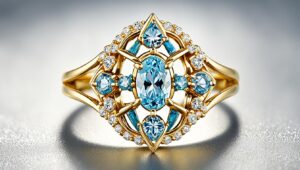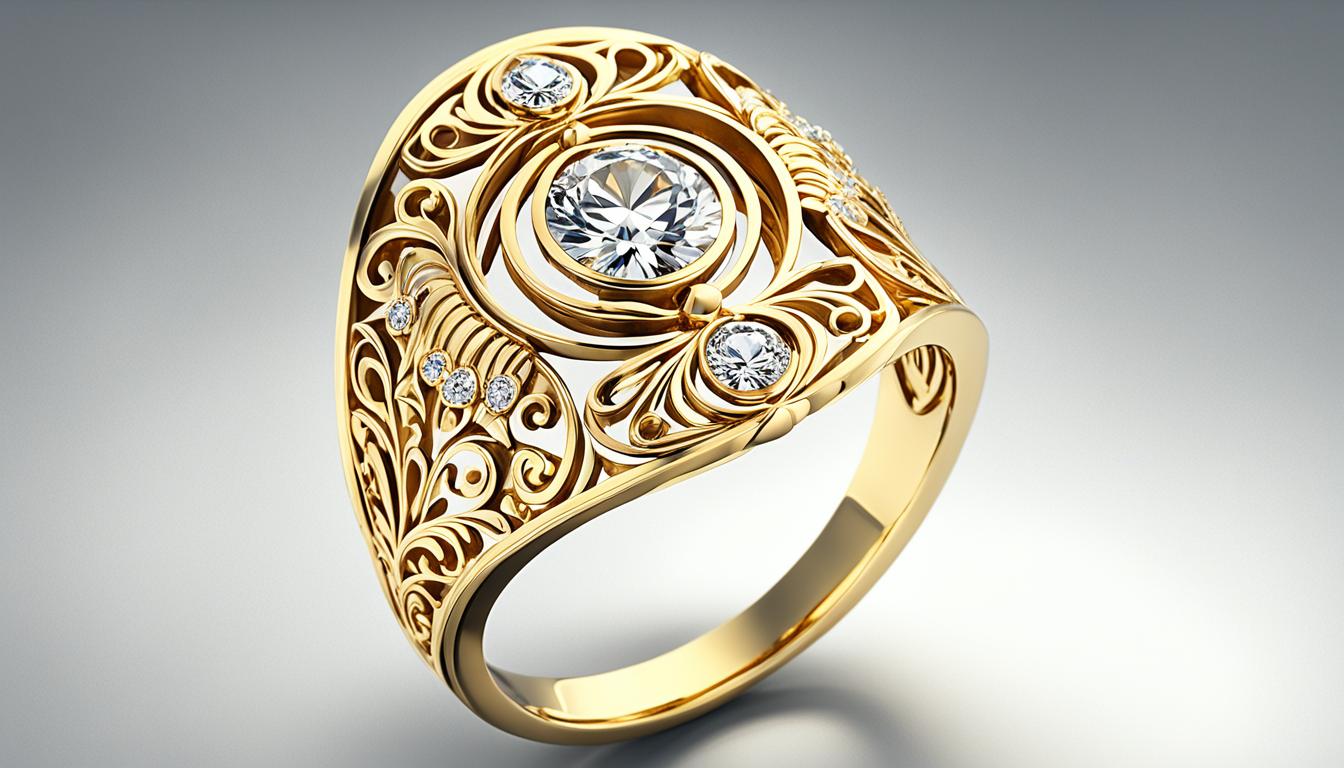Gold rings are not just about their shining beauty and value; they are also symbolic representations of love, commitment, and elegance. While the physical properties of gold make it a coveted metal, there are alternative ways to describe a gold ring that go beyond its inherent traits. Let’s explore some creative descriptions that capture the essence of a gold ring in unique and captivating ways.
Key Takeaways:
- Gold rings are not only beautiful and valuable but also carry deep symbolism.
- Alternative descriptions for gold rings can evoke emotions and capture the essence of love and commitment.
- Language such as “timeless elegance,” “symbol of eternal love,” and “exquisite craftsmanship” can be used to describe gold rings beyond their physical properties.
- Describing the emotions and sentiments associated with a gold ring can create a more meaningful connection with the audience.
- Using descriptive language that speaks to the uniqueness and personal significance of the gold ring can make it more desirable and memorable.
The Noble Metals – A Timeless Beauty
Gold, silver, and platinum are considered noble metals. They resist oxidation and corrosion in moist air and possess varying degrees of resistance to acids. These metals occur worldwide but not in large enough quantities to render them less valuable. Historically and currently, many cultures consider these metals beautiful, sensuous, and glamorous. They are also practical choices for jewelry making due to their malleability. These characteristics contribute to the enduring popularity of gold, silver, and platinum in the jewelry industry.
The noble metals, including gold, silver, and platinum, have captivated civilizations for centuries with their timeless beauty. These precious metals possess unique qualities that make them highly coveted for creating exquisite pieces of jewelry.
“Gold, silver, and platinum are not just precious metals; they are symbols of elegance, luxury, and refinement. Their resistance to tarnish and corrosion, coupled with their inherent beauty, makes them the perfect choice for crafting cherished jewelry pieces that stand the test of time.”
Gold, in particular, has a rich history dating back thousands of years. Its lustrous yellow hue and unparalleled shine have mesmerized people from all walks of life. Silver, with its brilliant white color and stunning reflectivity, has been treasured for its elegance and versatility. Platinum, known for its rarity and durability, exudes a cool, silvery-white radiance that complements any gemstone.
Jewelry made from these noble metals not only holds significant monetary value but also carries emotional and cultural significance. From wedding bands to statement necklaces, these metals have been etched into the fabric of our traditions and celebrations.
Why are noble metals so desirable for jewelry making?
One of the key reasons noble metals like gold, silver, and platinum are favored in jewelry making is their resistance to oxidation and corrosion. Unlike other metals that tarnish over time, these precious metals retain their natural beauty and shine for generations. This durability ensures that jewelry made from noble metals remains as stunning as the day it was crafted.
Furthermore, noble metals possess incredible malleability, allowing skilled artisans to mold and shape them into intricate designs. Their ductility enables the creation of delicate filigree work and fine details that enhance the allure of the finished piece.
The scarcity of noble metals also contributes to their value and desirability. Although these metals can be found in different parts of the world, their limited availability makes them even more precious. This scarcity lends an air of exclusivity to jewelry made from noble metals, making them highly sought after.
Whether it’s a gleaming gold necklace, a radiant silver bracelet, or an elegant platinum ring, jewelry made from noble metals symbolizes not only wealth and luxury but also timeless beauty and enduring craftsmanship.
| Noble Metal | Color | Tarnish Resistance | Malleability |
|---|---|---|---|
| Gold | Yellow | High | High |
| Silver | White | Moderate | High |
| Platinum | Silvery-white | High | Moderate |
Exploring the Properties of Gold
Besides its timeless beauty, gold possesses physical properties that make it a favored metal for jewelry making. It is known for its workability and durability, as it does not tarnish or corrode. Gold can be stretched into a thread more than 50 miles long from a single ounce and can cover 100 square feet in area when rolled into a sheet. It is also resistant to most acids, with only a few rare substances being able to damage it. These properties contribute to the longevity and value of gold jewelry.

Gold’s unique physical properties make it an extraordinary metal for jewelry. Apart from its radiant beauty, gold is highly malleable and ductile, allowing it to be shaped into intricate designs without breaking. Its remarkable durability ensures that gold jewelry can withstand the test of time, making it a precious heirloom to be treasured for generations.
Gold’s resistance to tarnishing and corrosion is another remarkable feature. Unlike many other metals, gold does not rust or decay, maintaining its luster and shine with minimal care. This quality contributes to the enduring value of gold jewelry, as it can remain pristine and beautiful even after many years of wear.
With its ability to withstand most acids, gold is highly resistant to chemical damage. It takes only a few rare substances, such as aqua regia, to dissolve gold, highlighting its exceptional stability. This resistance to chemical reactions ensures that gold jewelry retains its integrity and beauty under various environmental conditions.
In addition to its physical properties, gold also possesses captivating chemical properties. These properties include its high corrosion resistance, which allows gold to retain its brilliance over time. Gold also has a unique affinity for bonding with other metals, making it an ideal choice for creating durable gold alloys.
The Brilliance of Gold:
“Gold’s physical properties make it a cherished metal for jewelry, amplified by its unmatched beauty and unmistakable radiance. Its unique features add value and desirability to gold jewelry, allowing it to endure as a symbol of elegance and luxury.”
Properties of Gold – Visual Comparison:
| Physical Properties | Gold | Silver | Platinum |
|---|---|---|---|
| Malleability | High | Medium | Low |
| Durability | High | Medium | High |
| Resistance to Tarnishing | High | Medium | High |
| Chemical Stability | High | High | High |
Gold’s physical properties, such as its high malleability and excellent resistance to tarnishing, set it apart from silver and platinum. While silver shares similar characteristics, platinum excels in durability, making it an ideal choice for jewelry that requires extra strength. However, gold’s unique combination of workability, durability, and resistance to corrosion make it a standout metal for crafting exquisite jewelry.
By understanding the properties of gold, both physical and chemical, we can better appreciate the enduring beauty and value of gold jewelry. These characteristics make gold a precious metal that continues to captivate and inspire, leaving a lasting impression on generations to come.
Gold Alloys – Strengthening the Metal
While gold has desirable properties, such as its timeless beauty and workability, its inherent softness can lead to potential durability concerns. To overcome this challenge, jewelers often mix gold with other metals to create gold alloys. These alloys not only strengthen the metal but also enhance its durability, making it more suitable for everyday wear.
The process of mixing metals with gold involves combining it with various other elements, such as silver, copper, nickel, iron, zinc, tin, manganese, cadmium, and titanium. Each alloy composition results in a different combination of physical and chemical properties that contribute to the overall strength and durability of the gold alloy.
For example, silver is commonly alloyed with gold to create a stronger and more durable metal. The addition of copper to gold alloys results in a reddish hue, known as rose gold. Nickel and zinc can be used to create white gold, providing an alternative to traditional yellow gold.
“Gold alloys are the perfect solution for those seeking a balance between the allure of gold and the need for a durable piece of jewelry.”
It is important to note that while gold alloys offer increased strength and durability, some individuals may experience skin staining or allergic reactions due to the presence of alloyed metals. If you have specific metal sensitivities or concerns about skin reactions, it is advisable to consult with a trusted jeweler who can guide you in selecting the right gold alloy for your needs.
Commonly Used Metals in Gold Alloys
| Metal | Properties |
|---|---|
| Silver | Enhances strength and malleability. |
| Copper | Provides a reddish hue and improves overall durability. |
| Nickel | Creates white gold and increases hardness. |
| Iron | Contributes to strength and hardness. |
| Zinc | Used to create white gold with a lustrous appearance. |
| Tin | Aids in the casting process of gold alloys. |
| Manganese | Increases strength and improves casting properties. |
| Cadmium | Provides increased strength and durability. |
| Titanium | Improves the overall strength and corrosion resistance of gold alloys. |

Understanding Karat – The Purity of Gold
When discussing gold and its alloys, the term karat indicates the purity of the gold. Pure gold, with no other metals, is considered 24-karat gold. Alloys used in jewelry making range from 9-karat gold, which is approximately 37% pure gold, to 24-karat gold. Each karat has a corresponding percentage of gold content. For example, 18-karat gold is 75% pure gold, while 14-karat gold is 58.33% pure gold. The karat is required to be stamped and hallmarked according to its purity.
Did you know?
The term “karat” originates from the carob tree, whose seeds were used as a standard for measuring the weight of gold back in ancient times. Today, it is used to describe the purity of gold.
The Importance of Karat in Jewelry Making
The karat of gold alloys is a crucial factor in jewelry making. It determines the purity of the gold and affects the durability, color, and price of the piece. Understanding karat can help you make informed decisions when purchasing gold jewelry.
Gold Purity Scale
The following table illustrates the gold purity scale and the corresponding karat percentages:
| Karat | Purity (%) |
|---|---|
| 24 | 100% |
| 22 | 91.7% |
| 18 | 75% |
| 14 | 58.33% |
| 9 | 37.5% |
As the karat decreases, the gold content in the alloy decreases as well. While higher karat gold is more valuable, it is also softer and more prone to scratching or bending. Jewelry with lower karat gold, on the other hand, is more durable due to the higher presence of other metals.
Gold Alloys and Karat
Gold alloys are created by combining pure gold with other metals to enhance its strength and durability. These metals, such as silver, copper, nickel, or zinc, are added in specific proportions to achieve the desired karat and properties. By alloying gold, jewelers can create a wide range of gold jewelry with varying colors and physical characteristics.
Understanding the karat of gold is essential for both buyers and sellers of gold jewelry. It ensures transparency, as the karat is stamped and hallmarked on the piece. Whether you prefer the warm glow of 24-karat gold or the strength and affordability of lower karat alloys, knowing the purity of gold can help you make informed decisions and appreciate the craftsmanship of your gold jewelry.
Exploring Colored Gold – Beyond Yellow
Gold’s color can change when it is alloyed with different metals. This allows for a wide range of colored gold alloys, offering diverse options in the world of gold jewelry.
When copper is mixed with gold, it creates a darker yellow color, adding depth and richness to the metal. On the other hand, adding nickel or zinc to gold produces white gold, which provides a sleek and modern look.
But the possibilities don’t stop there. Other metals like silver, copper, and iron can create green, red, or blue gold alloys, offering even more unique and eye-catching options. Each color of gold alloy has its own distinctive properties and characteristics, allowing for a truly individualized piece of jewelry.
These colored gold alloys give jewelry designers the ability to play with different shades and hues, enabling them to create stunning pieces that suit various style preferences and occasions.
Enhancing Aesthetics with Colored Gold Alloys
The ability to create different colors of gold alloys opens up new horizons for jewelry designers and wearers alike. The choice of colored gold allows for the creation of stunning, one-of-a-kind pieces that reflect personal style and taste.
“Colored gold alloys enable jewelry designers to explore their creativity and offer customers a wider range of options. The choice of colors adds depth and uniqueness to the design, resulting in truly extraordinary pieces.” – Jennifer Smith, Jewelry Designer
In addition to its inherent beauty, colored gold alloys also offer the same durability and workability as traditional yellow gold. This ensures that the jewelry remains strong and can withstand the test of time, while still captivating with its unique color.
The image above showcases the stunning variety of colors that can be achieved with gold alloys, demonstrating the limitless possibilities of colored gold in the world of jewelry.
Whether it’s a vibrant green gold ring or an elegant blue gold necklace, colored gold alloys provide a wealth of options for those looking to make a statement with their jewelry.
Next, we will explore the different terminology used in the gold jewelry industry to better understand the language and labeling associated with gold products.
Gold Terminology – Understanding the Language
In the world of jewelry, understanding gold terminology is essential. Precise labeling ensures that customers can make informed decisions about the gold jewelry they are purchasing. Let’s explore the key terms and concepts related to gold purity, labeling, and more.
Gold Purity Labeling
Gold purity is denoted by the term karat (K) or carat (Ct). It specifies the percentage of gold in a piece of jewelry. Pure gold is 24-karat gold, while lower karatages indicate a lower percentage of gold content. A standard gold purity scale includes 24K, 22K, 18K, 14K, and 10K.
Gold Jewelry Labeling
When purchasing gold jewelry, it’s important to understand the labels used. Vendors can label an item as “solid gold” only if it is made from 24-karat gold. If a piece of jewelry contains a lower percentage of gold, it must be labeled with its karat value. For example, 18-karat gold jewelry will be labeled as such.
In addition to karat labeling, the type of gold used in jewelry can be denoted by terms like “gold plated” or “gold filled.” These terms refer to different techniques of applying a layer of gold onto a base metal.
Gold Solder
Gold solder is a crucial material used in jewelry making to join gold pieces together. It is an alloy that has a lower melting point than the metal being soldered. Gold solder comes in various karat values to match the gold used in the jewelry. This ensures a seamless and visually appealing result.
Gold Overlay
Gold overlay, also known as gold vermeil, offers an affordable option for those who desire the look and feel of gold jewelry. It involves applying a thin layer of gold onto a base metal, often sterling silver or brass. The gold overlay provides the desired aesthetic while utilizing less expensive metals.
Understanding these gold terminologies can empower customers to make educated choices when purchasing gold jewelry. Knowing the difference between solid gold, gold alloys, and gold overlay can help individuals find the perfect piece that suits their preferences and budget.
Conclusion
Gold rings are not just defined by their physical properties; they can be described in various ways that capture their beauty and significance. Exploring alternative terms and creative descriptions allows for a deeper understanding of a gold ring’s essence. By understanding the properties of gold and the effects of alloying and coating processes, one can create unique and diverse descriptions.
The choice of gold alloys enhances the durability and strength of a gold ring, while also offering a range of colors that go beyond the traditional yellow hue. Understanding how different metals can be combined with gold opens up a world of possibilities for stunning and personalized jewelry pieces.
Gold terminology is also essential in the jewelry industry, ensuring clear communication and accurate labeling. Knowing the karat and gold purity of a ring allows buyers to make informed decisions and guarantees the quality of their purchase. Additionally, the use of gold overlay pieces provides an affordable option for those who desire the look and feel of gold jewelry.
In conclusion, describing a gold ring involves more than just its properties. It requires an appreciation for the artistry, craftsmanship, and the unique journey that gold undertakes to become a precious piece of jewelry. By exploring the multitude of ways to describe a gold ring, one can truly capture its essence and convey its beauty and significance to others.




